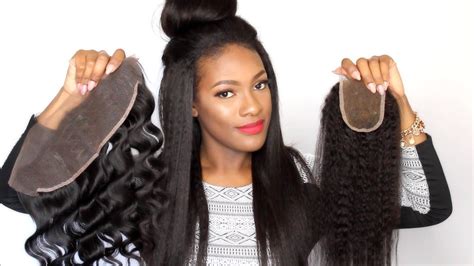In the realm of hair extensions, lace front frontals reign supreme, offering the most natural-looking and versatile hairpieces. This comprehensive guide will delve into everything you need to know about lace front frontals, from choosing the right one to styling and maintaining it for flawless hair.

What is a Lace Front Frontal?
A lace front frontal is a hairpiece that covers the entire front hairline of your head. It’s made of a sheer lace material that mimics the appearance of your scalp, providing a seamless and undetectable transition between your natural hair and the extensions.
Why Choose a Lace Front Frontal?
Lace front frontals are becoming increasingly popular due to their numerous advantages:
- Natural Appearance: The sheer lace material creates an illusion of natural growth, making it difficult to distinguish the frontal from your real hair.
- Versatility: Frontals allow you to customize your hairstyle, from sleek ponytails to volume-boosting buns, without worrying about visible tracks or wefts.
- Customizable: They can be cut, colored, and styled just like your natural hair to match your desired look.
- Confidence-Boosting: A well-installed frontal can significantly boost your confidence by giving you fuller, more voluminous, and flawless hair.
Choosing the Right Lace Front Frontal
Selecting the perfect lace front frontal is crucial for optimal results. Here are some key factors to consider:
- Lace Type: Choose between Swiss lace (thinner and more invisible) or HD lace (more durable and color-matched to your skin tone).
- Lace Density: The density of the lace determines how visible it will be. Opt for a higher density (e.g., 130%) for a more natural look.
- Knotting: The method used to secure the hair to the lace (e.g., double or triple knots) affects the durability and undetectability of the frontal.
- Length and Texture: Select the length and texture that complements your natural hair to create a seamless blend.
Pain Points and Motivations of Lace Front Frontal Users
Pain Points:
- Cost: Lace front frontals can be expensive, especially for higher-quality options.
- Maintenance: They require regular washing, conditioning, and styling to maintain their flawless appearance.
- Expertise: Installing and maintaining a lace front frontal requires skill and practice.
Motivations:
- Desire for Flawless Hair: Lace front frontals offer a solution for achieving natural-looking, voluminous, and stylish hair.
- Confidence Boost: The ability to customize and style the frontal to match personal preferences empowers wearers with increased confidence.
- Versatility: Frontals allow for endless styling possibilities, enabling users to experiment with different looks and enhance their overall aesthetic.
Tips and Tricks
- Professional Installation: For optimal results, have your lace front frontal installed by a skilled hairstylist who specializes in lace work.
- Proper Maintenance: Use sulfate-free shampoos and conditioners to protect the lace and hair. Avoid excessive heat styling and detangle gently with a wide-tooth comb.
- Custom Color Transformation: If the frontal doesn’t match your hair color exactly, consider consulting a hair colorist for a professional color match.
- Layering: Adding natural hair under the frontal can create added volume and depth, making the transition from your natural hair to the frontal even more seamless.
Common Mistakes to Avoid
- Installing Too Tightly: Overtightening the frontal can cause discomfort, hair breakage, and damage to your natural hairline.
- Using Incorrect Adhesive: Not all adhesives are created equal. Use a lace glue or tape specifically designed for lace frontals to ensure a secure and damage-free hold.
- Overusing Products: Excessive use of styling products can weigh down the hair and make it look greasy. Use products sparingly and focus on protecting the lace and hair.
- Not Addressing Ingrown Hairs: Ingrown hairs can occur around the edges of the frontal. Gently exfoliate the area to prevent irritation and remove ingrown hairs.
Tables
Table 1: Lace Types and Characteristics
| Lace Type | Characteristics |
|---|---|
| Swiss Lace | Thin, transparent, and invisible |
| French Lace | More durable than Swiss lace, but less transparent |
| HD Lace | Color-matched to skin tone, offering the most realistic look |
| Transparent Lace | Suitable for light skin tones, may require additional concealer |
Table 2: Lace Density and Appearance
| Lace Density | Appearance |
|---|---|
| 120% | Light and airy, visible at close range |
| 130% | Natural-looking, less visible than 120% |
| 150% | Dense, less transparent, can appear bulky if not installed correctly |
Table 3: Applications of Lace Front Frontals
| Application | Benefits |
|---|---|
| Enhancing Hairline | Creating a natural-looking hairline for thinning or receding hair |
| Adding Volume | Boosting the volume of thin or fine hair by adding length and thickness |
| Concealing Baldness | Providing a semi-permanent solution for hair loss or alopecia |
| Creative Styling | Enabling intricate hairstyles, such as updos, braids, and ponytails, without worrying about visible tracks |
Table 4: Estimated Costs of Lace Front Frontals
| Quality | Cost |
|---|---|
| Low | $50-$150 |
| Medium | $200-$400 |
| High | $500-$1,000+ |
Conclusion
Lace front frontals have revolutionized the hair extension industry by providing the most natural-looking and versatile hairpieces available. By understanding the factors that influence their appearance and performance, you can choose and maintain a lace front frontal that perfectly complements your unique style and hair goals. Embrace the transformative power of lace front frontals and enjoy flawless hair that empowers you with confidence and endless styling possibilities.
